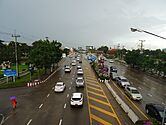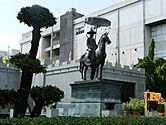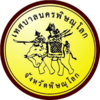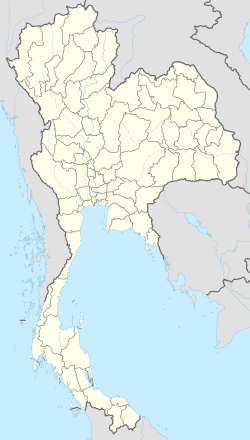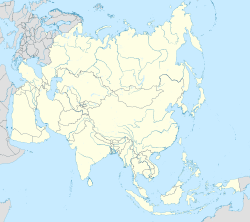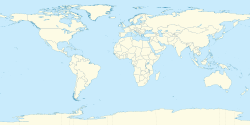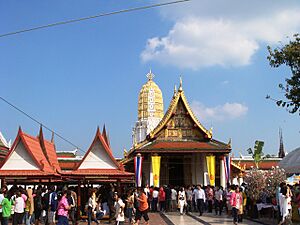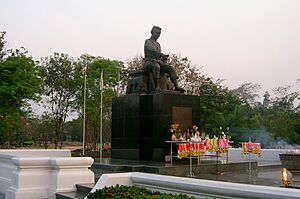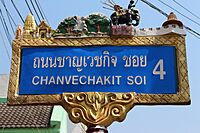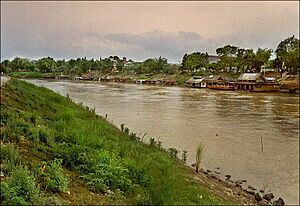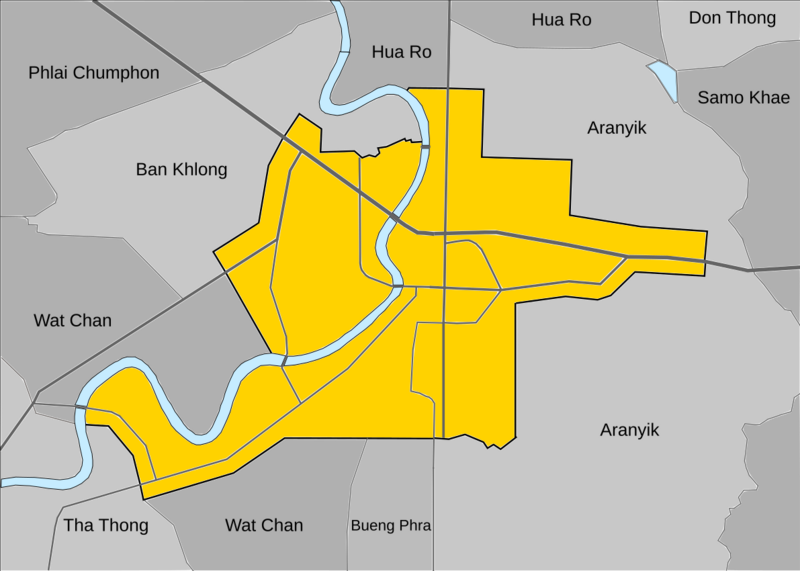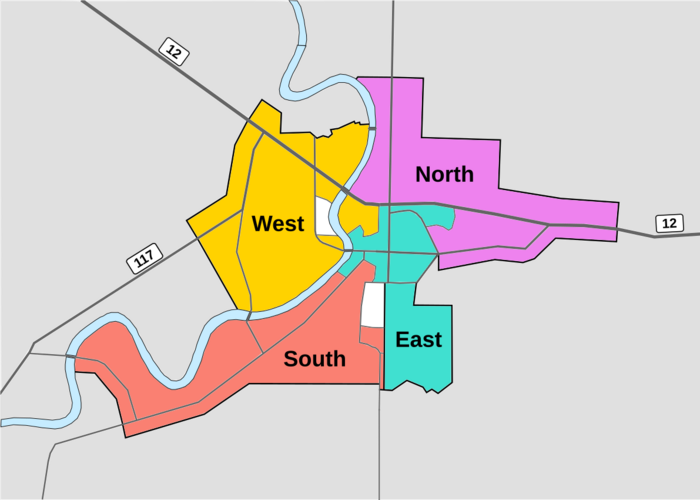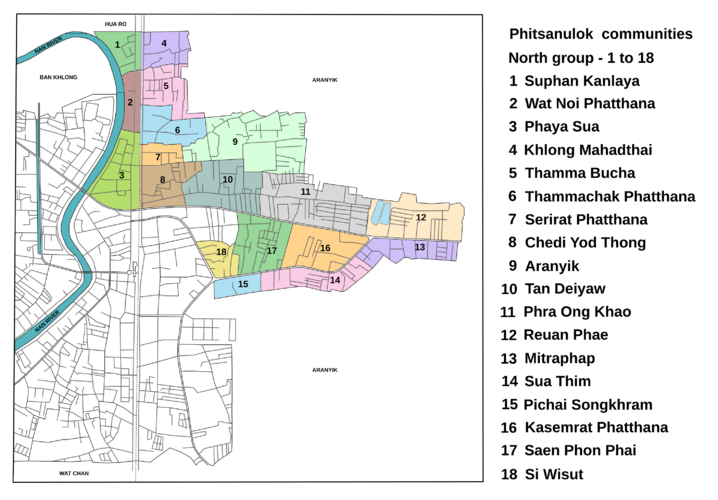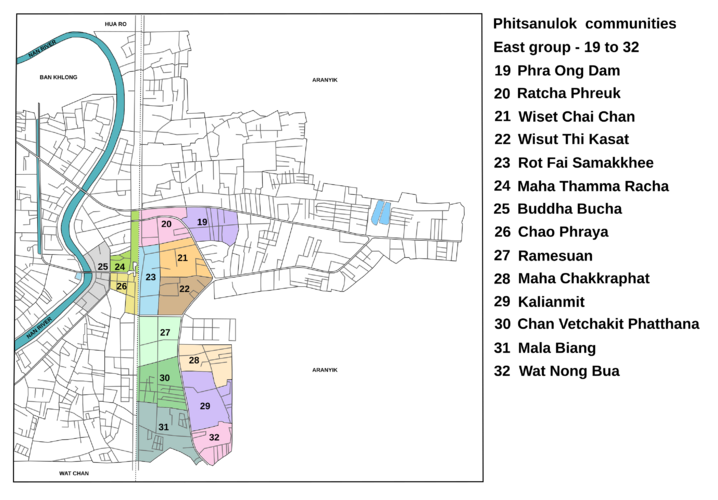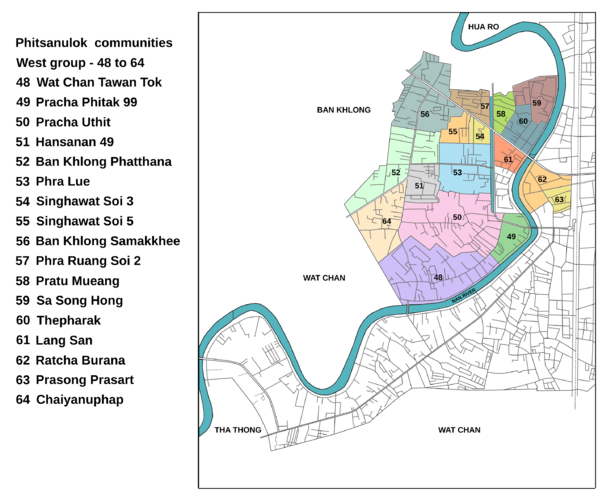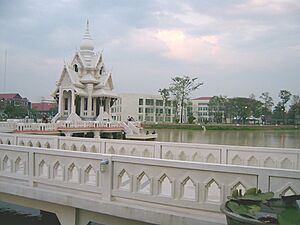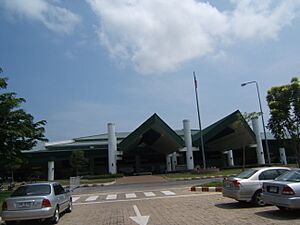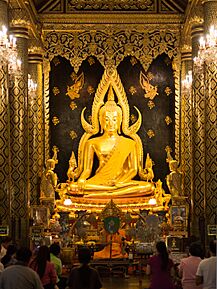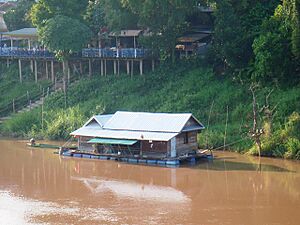Phitsanulok facts for kids
Quick facts for kids
Phitsanulok
พิษณุโลก
Song Khwae • สองแคว
|
||
|---|---|---|
|
City Municipality
|
||
| Phitsanulok city เทศบาลนครพิษณุโลก |
||
|
Clockwise from top:
The route 12, Chan Royal Palace Historical Center, Wat Aranyik, Rama I Equestrian Statue, Phitsanulok Clock Tower, Wat Phra Si Rattana Mahathat |
||
|
||
| Country | ||
| Province | ||
| District | Mueang Phitsanulok District | |
| Government | ||
| • Type | City municipality | |
| Area | ||
| • City Municipality | 18.26 km2 (7.05 sq mi) | |
| • Urban | 777 km2 (300 sq mi) | |
| Elevation | 51 m (167 ft) | |
| Population
(2022)
|
||
| • City Municipality | 62,584 | |
| • Rank | 10th (Urban) | |
| • Density | 3,427.4/km2 (8,876.9/sq mi) | |
| • Urban | 281,929 | |
| Time zone | UTC+7:00 (ICT) | |
| Postal code |
65000
|
|
| Calling code | (+66) 55 | |
| Geocode | 650101 | |
| Chief roadway | Route 12 | |
| Chief watercourse | Nan River | |
| Chief airport | Phitsanulok Airport | |
Phitsanulok is a lively city in Northern Thailand. It is the capital of Phitsanulok province and one of the largest cities in Thailand. About 360 kilometers (224 miles) north of Bangkok, Phitsanulok is home to over 280,000 people. The city was founded in the 13th century and is one of Thailand's oldest cities. It was first called Song Khwae.
Contents
- What's in a Name?
- A Look Back in Time: Phitsanulok's History
- City Symbols
- Where is Phitsanulok?
- How the City is Governed
- People of Phitsanulok
- Learning and Education
- Staying Healthy: Healthcare
- Getting Around: Transportation
- News and Media
- Military Presence
- Beautiful Temples
- Sports and Fun
- Culture and Arts
- Other Cool Places to Visit
- Fun Festivals and Events
- Images for kids
- See also
What's in a Name?
Have you ever wondered about the meaning behind city names? Phitsanulok has two interesting names from its past:
Song Khwae: The Two Rivers City
- The first name, Song Khwae, means 'two rivers'. This is because the city was once located where two rivers met.
Phitsanulok: Vishnu's Heaven
- The name Phitsanulok comes from two older words. Phitsanu is like 'Vishnu', a Hindu god. Lok means 'world' or 'globe'. So, a good way to understand Phitsanulok is 'Vishnu's heaven'.
A Look Back in Time: Phitsanulok's History
Phitsanulok is a very old city, more than 600 years old! It was an important center for the Khmer Empire a long time ago.
From Song Khwae to Royal City
- The city was first called "Song Khwae" because it was between the Nan and Khwae Noi Rivers.
- King Maha Thammaracha I of Sukhothai founded Song Khwae on the east bank of the Nan River. He also built the famous Wat Phra Si Rattana Mahathat temple and created the beautiful Buddha images of Phra Buddha Chinnarat.
- Song Khwae became very important, even more so than Sukhothai. In 1378, it became the main royal city of the Sukhothai Kingdom.
- Later, in 1448, when Prince Ramesuan became King Borommatrailokkanat of Ayutthaya, Song Khwae joined the Ayutthaya Kingdom.
Phitsanulok During Wars
- During a war between Ayutthaya and Lanna, King Trailokanat moved his home to Song Khwae in 1464. He then changed the city's name to "Phitsanulok".
- He made the city bigger, extending it to the west side of the Nan River.
- For a while, Phitsanulok was home to the Uparaja, who was like a prince or heir to the Ayutthaya throne.
- The city saw many battles during the Burmese-Siamese Wars. In 1563, when King Bayinnaung invaded, the ruler of Phitsanulok agreed to be under Burmese rule.
- In 1570, Prince Naresuan became the Uparaja of Phitsanulok. He later became a very famous king.
- To prepare for more invasions, Prince Naresuan ordered people to move from Phitsanulok and other northern cities to the south in 1584. Phitsanulok was left empty for a time.
- The city was rebuilt in 1593 and became a major administrative center in the north.
Recovery and Modern Times
- After the fall of Ayutthaya in 1767, Phitsanulok was controlled by a local lord.
- King Taksin of Thonburi took the city in 1768.
- In 1775, the Burmese attacked Phitsanulok again. The city was bravely defended for four months but eventually fell and was badly damaged.
- Phitsanulok was mostly in ruins and had very few people for many years.
- In 1834, people from Laos were brought to help repopulate Phitsanulok and nearby areas. The city slowly started to grow again.
- In 1894, Phitsanulok became an important administrative center for the region.
- A big fire in 1957 destroyed many old wooden buildings in the city.
- The King Naresuan Shrine was finished in 1961.
- In 1967, Naresuan University was started in Phitsanulok. It was named after King Naresuan the Great.
- The Naresuan Dam was built between 1976 and 1985 to help prevent floods in the city.
- In 1999, Phitsanulok officially became a city municipality.
City Symbols
Phitsanulok has symbols that show its history and culture.
- The older street sign (left) shows:
- Three figures from Wat Yai: Phra Attharot (a tall Buddha statue), the prang (a tall tower), and the entrance gate of Vihara Luang (where the Buddha Chinnarat is kept).
- A nature park with a waterfall.
- Houseboats on the Nan River.
- King Naresuan riding his war elephant.
- A hat-shaped tower.
- The modern street sign (right) shows:
- The official seal of Phitsanulok City with King Naresuan on his war elephant.
- The words "Phitsanulok City" in Thai.
Where is Phitsanulok?
Phitsanulok is located in the northern part of Thailand. It is about 377 kilometers (234 miles) north of Bangkok by road.
Borders and Natural Features
- Phitsanulok covers about 777 square kilometers.
- To the north, it borders Uttaradit and Laos.
- To the northeast, it borders Loei and Phetchabun.
- To the south, it borders Phichit.
- To the west, it borders Kamphaeng Phet Province and Sukhothai.
- The area has many waterfalls, forests, and caves.
- The northern and northwestern parts are highlands, popular for places like Kaeng Sopha waterfall and Phu Hin Rong Kla.
- The southern plains, along the Yom River and the Nan River, are important for farming.
Rivers and Landscape
- Phitsanulok is mostly flat, with some hills and wooded areas in the east.
- It is part of the Nan River Basin.
- The city is sometimes called Song Kwae, meaning 'city of two rivers'. This name comes from a time when the Nan and Khwae Noi Rivers met near the city.
- Today, only the Nan River flows through Phitsanulok.
Weather in Phitsanulok
Phitsanulok has a tropical savanna climate. This means it has dry, very warm winters.
- Temperatures rise until April, which is the hottest month.
- The monsoon season runs from May to October, bringing heavy rain and slightly cooler days, but warm nights.
| Climate data for Phitsanulok (1991–2020) | |||||||||||||
|---|---|---|---|---|---|---|---|---|---|---|---|---|---|
| Month | Jan | Feb | Mar | Apr | May | Jun | Jul | Aug | Sep | Oct | Nov | Dec | Year |
| Record high °C (°F) | 36.3 (97.3) |
38.4 (101.1) |
40.5 (104.9) |
42.8 (109.0) |
42.7 (108.9) |
39.4 (102.9) |
37.6 (99.7) |
36.7 (98.1) |
35.7 (96.3) |
35.7 (96.3) |
36.4 (97.5) |
35.3 (95.5) |
42.8 (109.0) |
| Mean daily maximum °C (°F) | 31.5 (88.7) |
33.5 (92.3) |
35.7 (96.3) |
37.2 (99.0) |
35.8 (96.4) |
34.3 (93.7) |
33.2 (91.8) |
32.6 (90.7) |
32.7 (90.9) |
32.6 (90.7) |
32.3 (90.1) |
31.0 (87.8) |
33.5 (92.4) |
| Daily mean °C (°F) | 24.9 (76.8) |
26.8 (80.2) |
29.1 (84.4) |
30.8 (87.4) |
30.1 (86.2) |
29.3 (84.7) |
28.6 (83.5) |
28.2 (82.8) |
28.2 (82.8) |
28.0 (82.4) |
26.9 (80.4) |
24.9 (76.8) |
28.0 (82.4) |
| Mean daily minimum °C (°F) | 19.2 (66.6) |
20.8 (69.4) |
23.7 (74.7) |
25.4 (77.7) |
25.4 (77.7) |
25.2 (77.4) |
24.8 (76.6) |
24.7 (76.5) |
24.7 (76.5) |
24.1 (75.4) |
22.0 (71.6) |
19.4 (66.9) |
23.3 (73.9) |
| Record low °C (°F) | 7.5 (45.5) |
10.0 (50.0) |
12.7 (54.9) |
17.4 (63.3) |
20.4 (68.7) |
21.0 (69.8) |
21.5 (70.7) |
21.4 (70.5) |
21.7 (71.1) |
17.1 (62.8) |
12.1 (53.8) |
8.9 (48.0) |
7.5 (45.5) |
| Average precipitation mm (inches) | 7.0 (0.28) |
16.6 (0.65) |
28.9 (1.14) |
59.2 (2.33) |
165.6 (6.52) |
161.1 (6.34) |
187.9 (7.40) |
240.7 (9.48) |
268.4 (10.57) |
139.1 (5.48) |
31.7 (1.25) |
12.9 (0.51) |
1,319.1 (51.93) |
| Average precipitation days (≥ 1.0 mm) | 1.0 | 1.3 | 2.4 | 3.8 | 10.0 | 11.9 | 14.4 | 15.6 | 15.2 | 9.4 | 2.2 | 0.7 | 87.9 |
| Average relative humidity (%) | 69.1 | 66.1 | 64.4 | 63.6 | 71.3 | 76.1 | 78.6 | 80.7 | 81.6 | 78.7 | 72.6 | 69.0 | 72.7 |
| Mean monthly sunshine hours | 258.7 | 252.2 | 265.6 | 271.9 | 243.3 | 186.5 | 150.8 | 141.1 | 160.7 | 209.4 | 246.3 | 257.7 | 2,644.2 |
| Mean daily sunshine hours | 8.3 | 8.6 | 8.9 | 8.1 | 6.4 | 3.9 | 3.9 | 3.8 | 3.6 | 5.8 | 7.3 | 8.3 | 6.6 |
| Source 1: World Meteorological Organization, (extremes) | |||||||||||||
| Source 2: Office of Water Management and Hydrology, Royal Irrigation Department (sun 1981–2010) | |||||||||||||
How the City is Governed
The Phitsanulok City Municipality manages an area of about 18.26 square kilometers. This area includes the tambon (subdistrict) of Nai Mueang, which has over 62,000 people.
The municipality is responsible for important services like clean water, waste disposal, controlling diseases, public education, hospitals, and electricity. The mayor, who is the main leader, is chosen by the people living in the city every four years. The mayor gets help from up to four deputy mayors. The Municipal Council makes the city's laws, which must follow the country's laws. These laws apply to everyone in the city. There are 64 communities in Phitsanulok, divided into four groups. These groups advise the local government.
People of Phitsanulok
Who Lives Here?
Most people in Phitsanulok are Thai. Some people in the city also have Mon family roots.
Languages Spoken
The main language spoken by people in Phitsanulok is Central Thai.
Beliefs and Religions
Most people in Phitsanulok follow Theravada Buddhism, which is the main religion in Thailand. There are also smaller groups of Christians and a few Muslim families.
Learning and Education
Universities and Colleges
Naresuan University is a major learning center in northern Thailand. It is named after King Naresuan the Great, and there is a large statue of him on campus. Other places for higher education in or near the city include:
- Phitsanulok University (a private university)
- Sirindhorn College of Public Health
- Rajabhat Pibulsongkram University (which used to train teachers)
- The Phitsanulok campus of the Rajamangala University of Technology Lanna.
Vocational Schools
There are three vocational colleges in the city where students can learn practical skills:
- Phitsanulok Technical College.
- Phitsanulok Vocational College.
- Songkwae Technical College.
High Schools (Mathayom)
Phitsanulok City has three main high schools:
- Chalermkwansatree School
- Janokrong school
- Puttha Chinnarat Pitthaya school
Staying Healthy: Healthcare
Phitsanulok City has one large government hospital, Buddhachinaraj Phitsanulok Hospital, with 1,000 beds. There are also five private hospitals with a total of 400 beds:
- Bangkok Hospital Phitsanulok
- Phitsanulok Hospital
- Pitsanuvej Hospital
- Ruamphaet Hospital
- Radiotherapy and Nuclear Medicine Hospital
Getting Around: Transportation
Airport Travel
Phitsanulok Airport is close to the city center. It has several flights each day from Bangkok, taking about 60 minutes. Three airlines fly to Phitsanulok: Nok Air, Thai Air Asia, and Thai Lion Air.
Roads and Highways
Road 126 is a multi-lane bypass that helps traffic go around Phitsanulok city. It connects to other major highways:
- Highway 11 to Uttaradit and Lampang in the north.
- Highway 12 to Phetchabun in the east.
- Highway 11 to Sing Buri in the south.
- Highway 117 to Nakhon Sawan in the south.
- Highway 12 to Sukhothai, Tak, and Mae Sot in the west.
Bus Services
Phitsanulok has two bus terminals, Terminal 1 (Saen Phon Phai) and Terminal 2 (Samo Khae). These terminals offer bus services throughout Phitsanulok Province, with about eight bus companies. There are also four minibus lines for travel within the city. One private bus company, Yanyon tour, has its own station for trips to Bangkok.
Train Travel
The Phitsanulok railway station is in the city center. It serves many intercity trains on the Northern Line each day, operated by the State Railway of Thailand.
News and Media
People in Phitsanulok get their news and entertainment from television and radio.
- Radio Stations:
- Air Force Radio Station (954 AM and 95.75 FM)
- 4th Infantry Division Radio (1377 AM)
- Police Communications Division Radio (1422 AM)
- Television Channels:
- ARMY-5 (Channel 5, run by the Royal Thai Army)
- PRD-11 (Channel 11, run by the Government Public Relations Department)
Military Presence
Phitsanulok is home to the Third Army Region of the Royal Thai Army. This part of the army is in charge of the northern and northwestern areas of Thailand.
Beautiful Temples
Phitsanulok is famous for its many beautiful temples.
Wat Phra Sri Rattana Mahathat (Wat Yai)
The most popular place to visit in Phitsanulok is Wat Phra Sri Rattana Mahathat. Locals call it Wat Yai (meaning 'the big temple').
- This famous temple was built in 1357.
- It is home to the Phra Buddha Chinnarat, one of Thailand's most respected Buddha statues. This statue is also the official symbol of Phitsanulok Province.
- The temple has beautiful doors decorated with mother-of-pearl, made in 1756 by King Boromakot.
- Inside the temple grounds, the Buddha Chinnarat National Museum displays many artworks from the Sukhothai period.
Other Temples to Explore
The city has many other temples where Theravada Buddhism is practiced:
- Wat Tammachak
- Wat Chedi Yod Thong
- Wat Aranyik
- Wat Nang Phaya (a monastery, not a temple)
- Wat Ratcha Burana
- Wat Mai Opai Yaram
- Wat Si Wisut Tharam
- Wat Nong Bua Mai
- Wat Tha Maprang
- Wat Sa Kaew Phatum Thong
- Wat Chan Tawan Ook
- Wat Chan Tawan Tok
- Wat Phan Pee
- Wat Kuha Sawan
Sports and Fun
Traditional Sports
Dragon boat racing has always been an important part of Phitsanulok's culture. These exciting races are a big event. Traditional Thai boxing is also a very popular sport in the city.
Modern Sports
Football (soccer) has become very popular. In 2005, Phitsanulok teams won championships in the U12 and U15 age groups.
Culture and Arts
Artistic Heritage
Phitsanulok is known for its many historic sculptures of the Buddha and other religious artworks. These include the famous Buddha Chinnarat, the Buddha Chinnasi, and the Phra Si Satsada.
Important Writings
Phitsanulok has inspired several important literary works, such as:
- Lilit Yuan Pai (Tale of the Fall of Lanna)
- Lilit Prá Lô (Tale of the Hero Lô)
- Klohng Táwâatsàmàat (Poem of the Twelve Months)
- Gam Sŏn Sĕe Bpràat (The Legendary Wise Archer's Grip)
The main language used in these writings and spoken in the city is the central Thai dialect, written in the Thai alphabet.
Other Cool Places to Visit
- Buranathai Buddha Foundry: This is a special place that makes bronze Buddha statues. It's the only one of its kind in the province. You can watch how they create copies of the Phra Buddha Chinnarat statue.
- Sergeant-Major Dr. Thawee Buranakhet Folklore Museum: This museum has a collection of folk art, crafts, pottery, and old kitchen tools. It also shows old traps used to catch animals.
- City Walls: Most of Phitsanulok's old buildings were destroyed in a fire in 1955. But you can still see a small part of the ancient city wall.
- Night Market: Every evening, vendors set up stalls for Phitsanulok's night market. You can find clothes and food, often at good prices.
- Chan Palace: This palace was the birthplace of King Naresuan the Great. There is a shrine here dedicated to him.
- Naresuan University Art and Culture Gallery: This gallery displays over 100 artworks by important Thai artists.
- Nan River Houseboats: Phitsanulok is known for the houseboats that used to line the Nan River near Wat Phra Sri Rattana Maharat. There is a houseboat museum you can visit to learn about them.
Fun Festivals and Events
- Phra Buddha Chinnarat Fair: This fair is held every January at Wat Phra Sri Rattana Mahatat Woramahawihan.
- Suan Chom Nan Park Festival: This festival happens twice a year along the Nan River. You can find food and local products for sale.
- Dragon Boat Races: On the first weekend of October, exciting dragon boat races are held on the Nan River outside Wat Phra Sri Rattana Mahatat Woramahawihan. Each boat has about 30 rowers!
Images for kids
See also
 In Spanish: Phitsanulok para niños
In Spanish: Phitsanulok para niños


